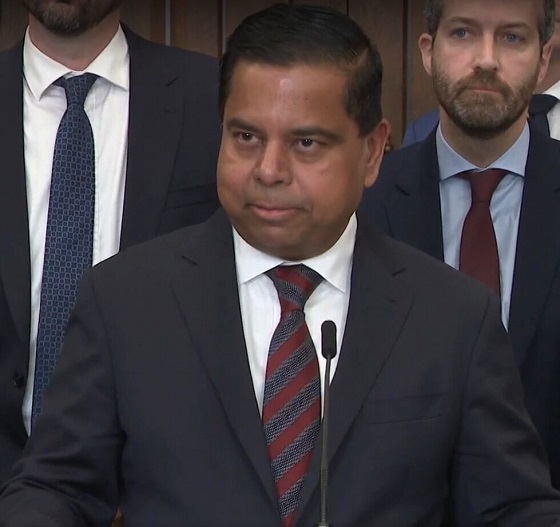conflict
‘Wickedly Complex Situation’: Trump Will Face Another Foreign Policy Powder Keg On Day One

From the Daily Caller News Foundation
By Wallace White
President-elect Donald Trump will have to deal with another volatile situation in Syria as a new faction toppled Syrian President Bashar al-Assad’s 24-year regime, setting the stage for another potentially protracted conflict.
The al-Assad dictatorship came crashing down Saturday after rebels led by Islamic group Hayat Tahrir al-Sham (HTS) seized Syria’s capital in Damascus, bringing a bloody conflict to a close that has raged since 2011. However, the potential for conflicts among other rebel factions mixed in with Israeli, Russian and U.S. operations in the country creates a precarious situation that could ignite at any moment, presenting the incoming Trump-Vance administration with a major foreign policy challenge on day one.
“It’s a wickedly complex situation that definitely has a lot of U.S. interest,” Brent Sadler, senior research fellow for the Allison Center for National Security at the Heritage Foundation, told the Daily Caller News Foundation. “I think that’s the first thing to acknowledge upfront is [that] it doesn’t necessarily mean we have to be more militarily engaged than we are already, but at the same time signaling readiness to reward those that share our interests and values, and to punish those who don’t. It’s the early days, quite frankly, to know exactly how the power situation is going to play out in Syria.”
HTS was designated by the U.S. as a foreign terrorist organization in 2018 under the Trump administration, according to the Office of the Director of National Intelligence. The group first organized in 2017 when the former leader of al-Qaeda’s Syrian branch, Abu Muhammad al-Jawlani, split with the organization over strategic differences.
Al-Jawlani was formerly detained by U.S. forces during the invasion of Iraq, being let out in 2011, according to The Wall Street Journal. Al-Jawlani reportedly expressed a moderate position on minorities like Christians staying in their country, however some are still anxious as to what he may ultimately end up doing on the matter.
“At some point back in 2018 to 2019, al-Jawlani makes a break from the ideology of ISIS and certainly al-Qaeda, because I think he realized there is no way to unify the Syrian people to topple Assad’s regime without moderating their very radical Salafist ideology,” Sadler told the DCNF. “They’re still Islamist, but I think they’re trying to moderate themselves for very pragmatic reasons.”
The two most influential factions other than HTS include the U.S.-backed Kurdish Syrian Defense Force (SDF) and the Turkish-backed Syrian National Army (SNA).
The SNA formed in 2017 out of various rebel groups in northern Syria to oppose the Assad regime and HTS, according to Middle East Eye. However, SNA joined the most recent offensive alongside HTS after the group took the city of Aleppo, according to Reuters.
The SNA are also currently fighting the SDF as well in the wake of Assad’s collapse, according to the Foundation for Defense of Democracies (FDD) Tuesday.
With HTS’ ascendancy adding profound uncertainty to the region, Trump stated in a post on Truth Social Saturday that he wants the U.S. to stay uninvolved in Syria, saying there was not much to gain for the U.S. in direct involvement at this time.
“What the Trump administration needs to think about is, ‘where in this does U.S. interest lie? How do we influence what’s happening there to our advantage?’” Simone Ledeen, former deputy assistant secretary of defense for the Middle East, told the DCNF. “Also, it’s important to note we have troops on the ground in Syria, and they’ve been taking fire for the last four years. What’s our desired strategic end-state in Syria? What do we need them to accomplish, besides taking fire from Iranian proxies?”
The U.S. operates al-Tanf military base in southern Syria, which has also served as the headquarters for operations against ISIS since 2016, according to the Council on Foreign Relations. During Assad’s rule, the U.S. operated the base against his will.
Currently, the U.S. has 900 troops stationed in Syria, according to the Pentagon. Trump, who ran on ending “forever wars,” attempted to withdraw troops from Syria in 2018 but faced enormous pushback from foreign policy hawks of both parties. Ultimately, the U.S. retained some troops in the nation mainly for anti-ISIS operations, according to Politico.
Israel has taken advantage of the power vacuum, seizing strategically vital areas in the Golan Heights region in southern Syria, according to The Washington Post Monday. The newly seized positions put Damascus within Israeli artillery range, Sadler told the DCNF.
The U.S. also conducted strikes on Sunday with Israel against ISIS targets.
In Damascus, the rebels appointed Mohamed al-Bashir, a former HTS opposition government member, as interim prime minister to solidify unity in the rebel front, according to Reuters Tuesday. John Hardie, Russia program deputy director at the FDD, told the DCNF that Trump needs to stay involved enough to work with whoever ends up maintaining power in the region.
“I think the next administration and their allies are really going to have to resist the temptation just to kind of watch from the sidelines,” Hardie told the DCNF. “We’re going to have to play an active role. I think our very small economy-of-force military presence we have in eastern Syria is a good thing for keeping a lid on ISIS. And I would hope that the next administration will kind of work hard with the actors who are coming to power, whatever that new government looks like.”
While Russia’s influence took a massive hit from the fall of Assad, Trump will still have to deal with their remaining pockets of influence while trying to negotiate peace in Ukraine.
Russia’s main chance at influencing the region is through the Alawites living on Syria’s western coast where Tartous Naval Base, Russia’s only port on the Mediterranean Sea, is located. The Alawites were a staunchly pro-Assad faction for most of the civil war, according to Reuters.
“Watch the Russians and watch Latakia,” Sadler told the DCNF. “If the Russians think they have a chance of reconstituting any influence, it’s probably going to be in and around their bases in Latakia. And again, that’s the Alawites, so if there’s any hope of that, that’s where it’s going to be.”
However, Hardie thinks now that Assad is out of the picture, the best hope of the Russians regaining their influence in the region lies in cooperating with the rebels.
“The Kremlin is certainly trying to now play nice with these groups, especially HTS,” Hardie told the DCNF. “You may have seen that just a few days ago, were calling them terrorists, and [Russian Foreign Minister Sergei] Lavrov was sort of chiding journalists for calling them ‘opposition’ rather than ‘terrorists,’ and saying they should never be allowed to. Now they’re saying they will engage with all parties, and the Russian state is calling them ‘armed opposition.’”
Secretary of State Antony Blinken said that he will back a Syrian government that respects minorities, condemns terrorism, bars the use of chemical and biological weapons and supports humanitarian assistance, according to a Tuesday press release.
“We continue to monitor the situation in Syria. President Trump is committed to diminishing threats to peace and stability in the Middle East and to protecting Americans here at home,” Trump-Vance Transition Spokesman Brian Hughes told the DCNF Wednesday.
conflict
Israel bombs Iranian state TV while live on air

 MxM News
MxM News
Quick Hit:
Israel struck Iran’s state-run television station during a live broadcast Monday, forcing an anchor to flee mid-sentence as debris rained down. The Israeli Air Force expanded its target list to include media arms of the Iranian regime after continued missile attacks on Israeli civilians.
Key Details:
-
The Israeli Air Force bombed Iran’s state broadcaster during a live segment, interrupting footage of Iranian missiles hitting Israel. An anchor was seen abandoning her post as the studio filled with smoke and debris.
-
The strike followed public warnings from Israel for residents in northeast Tehran to evacuate ahead of operations targeting regime-linked facilities.
-
Israel’s expanded military campaign follows a new wave of Iranian missile attacks Sunday night into Monday, with Jerusalem emphasizing its intent to avoid civilian casualties despite growing targeting of regime infrastructure.
BREAKING: The moment of the attack on IRIB (Iran State Broadcaster) pic.twitter.com/CVU26HHFub
— Faytuks Network (@FaytuksNetwork) June 16, 2025
Diving Deeper:
The Israeli Air Force carried out an airstrike Monday on Iran’s state-controlled television network while it was broadcasting live, part of a broader escalation in Israel’s campaign to dismantle Iran’s military and propaganda infrastructure.
According to footage circulating online, the incident occurred as the anchor—visibly agitated and dressed in a black chador—was delivering a harsh anti-Israel rant. In the middle of the broadcast, the screen darkened, the set shook, and debris began falling from the ceiling. The anchor turned and fled as the feed abruptly cut out. The moment marked a rare glimpse into the vulnerability of Iran’s tightly controlled state media under Israeli bombardment.
Israel had publicly urged civilians in northeast Tehran to evacuate earlier that day, signaling imminent attacks in the area. Initial expectations were that the Israel Defense Forces (IDF) would focus on military and intelligence targets. However, in light of Iran’s continued launches of ballistic missiles at civilian areas across Israel, Jerusalem has expanded its mission to include what it calls “political instruments of the regime”—which now appears to include its media apparatus.
While Iranian authorities maintain strict control over domestic news and heavily censor dissenting voices, Monday’s strike disrupted their messaging operation in real time. Iran’s state-run outlets have played a key role in promoting anti-Israel narratives and concealing internal dissent. Journalists in Iran face imprisonment or worse for crossing red lines laid out by the regime.
The Israeli military’s broader campaign has crippled Iranian air defenses, granting the IAF near-total air superiority over Tehran and much of the country. With that operational freedom, Israel has systematically struck IRGC command centers, missile sites, and now media outlets tied to the regime.
Despite the heightened intensity of the conflict, Israeli officials have reiterated that their strikes are aimed solely at regime targets, not civilians. Reports on social media indicated growing panic in Tehran, with widespread traffic as residents attempted to flee the capital.
Monday’s dramatic strike on state TV underscored Israel’s determination to degrade all facets of Iran’s war-making and propaganda capabilities—signaling that even live broadcasts from Tehran are no longer beyond the reach of Israeli precision airpower.
conflict
“Evacuate”: Netanyahu Warns Tehran as Israel Expands Strikes on Iran’s Military Command

 Sam Cooper
Sam Cooper
As President Donald J. Trump opened meetings with Western leaders at the G7 summit in Alberta early Monday, multiple reports signaled a dramatic escalation in Israel’s military campaign against Iran—a broader and potentially more lethal phase of the conflict. In a televised address, Prime Minister Benjamin Netanyahu urged citizens of Tehran to “evacuate,” confirming Israeli aircraft were operating deep inside Iranian airspace. Meanwhile, as U.S. military assets approach the Middle East by sea and air, Trump issued a stark warning to Iran’s leadership, cautioning against any retaliation targeting U.S. military assets in the region.
“We are telling the citizens of Tehran: evacuate,” Netanyahu reportedly declared from a secure facility beneath Tel Aviv. “We are taking action to eliminate the existential threat posed by Iran’s nuclear and ballistic missile program.”
Trump, speaking from Calgary hours before his closed-door G7 meetings, warned that any attack on U.S. military personnel or facilities “would be met with overwhelming force,” according to statements confirmed by Reuters.
The warnings accompanied a new wave of Israeli airstrikes early Monday targeting underground missile facilities, command bunkers, and air defense batteries across central Iran. Reuters, citing Israeli military officials, confirmed that dozens of warplanes were involved in the overnight operation, striking missile storage sites near Qom and key military complexes southwest of Tehran.
Israel also said it had struck the Tehran command center of Iran’s elite Quds Force, in what The New York Times and Reuters described as a major escalation in the deadliest confrontation between the two countries to date. Analysts note the Quds Force plays a central role in organizing the Iranian regime’s network of regional proxy militias.
Now in its fourth day, the conflict has claimed at least 224 lives in Iran and more than 20 in Israel, with thousands wounded. Israeli officials said eight people were killed in Monday’s strikes alone.
Iran’s Health Ministry reported more than 1,400 wounded, while Israeli authorities said some 600 have been injured since hostilities began.
Meanwhile, President Trump reportedly rejected an Israeli plan to assassinate Iran’s Supreme Leader Ayatollah Ali Khamenei, three U.S. officials told CBS according to BBC, in a report published Sunday. Trump reportedly told Netanyahu the plan was “not a good idea,” and the conversation is said to have taken place after Israel launched its first strike on Friday.
Unverified reports on Monday suggested that Iranian leaders may be seeking a diplomatic exit from the conflict by pledging to halt nuclear enrichment—but are also searching for a face-saving mechanism that would allow them to preserve regime legitimacy. These claims have not been confirmed by U.S. or Israeli intelligence but are circulating among regional analysts.
BBC News, citing regional correspondents and satellite imagery, reported sustained Israeli bombardments along a corridor stretching from Esfahan to the outskirts of Tehran. Footage broadcast by Iran’s semi-official Fars News Agency showed thick plumes of black smoke rising from industrial zones in Kermanshah and explosions near known missile research installations long suspected by Western governments of contributing to Iran’s nuclear infrastructure.
Iranian authorities, while acknowledging the scale of the attacks, have characterized them as “limited,” claiming that their air defense systems intercepted many incoming missiles.
According to the Wall Street Journal, U.S. early warning systems detected a flurry of retaliatory missile activity inside western Iran shortly after the Israeli strikes began. However, no launches were confirmed—fueling speculation that Iran’s top leadership is seeking to avoid a direct confrontation with the United States or Israel at this stage.
Still, the risks of an expanding war remain acute. U.S. Central Command has confirmed that naval and air assets—including carrier strike groups and long-range bombers—have been repositioned to heightened readiness levels across the Persian Gulf and Eastern Mediterranean.
The Bureau is a reader-supported publication.
To receive new posts and support my work, consider becoming a free or paid subscriber.
Invite your friends and earn rewards
-

 Alberta1 day ago
Alberta1 day agoAlberta’s grand bargain with Canada includes a new pipeline to Prince Rupert
-

 Business1 day ago
Business1 day agoCarney’s European pivot could quietly reshape Canada’s sovereignty
-

 Bruce Dowbiggin13 hours ago
Bruce Dowbiggin13 hours agoWOKE NBA Stars Seems Natural For CDN Advertisers. Why Won’t They Bite?
-

 Energy13 hours ago
Energy13 hours agoCould the G7 Summit in Alberta be a historic moment for Canadian energy?
-

 Crime13 hours ago
Crime13 hours agoMinnesota shooter arrested after 48-hour manhunt
-

 Crime2 days ago
Crime2 days agoManhunt on for suspect in shooting deaths of Minnesota House speaker, husband
-

 conflict7 hours ago
conflict7 hours agoIsrael bombs Iranian state TV while live on air
-

 Aristotle Foundation11 hours ago
Aristotle Foundation11 hours agoThe Canadian Medical Association’s inexplicable stance on pediatric gender medicine




